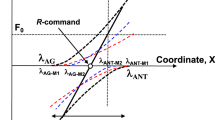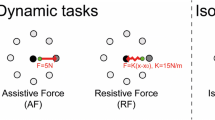Abstract
This study examined the patterns of muscle activity that subserve the production of dynamic isometric forces in various directions. The isometric condition provided a test for basic features of neuromuscular control, since the task was analogous to reaching movement, but the behavior was not necessarily shaped by the anisotropy of inertial and viscoelastic resistance to movement. Electromyographic (EMG) activity was simultaneously recorded from nine elbow and/or shoulder muscles, and force pulses, steps, and ramps were monitored using a transducer fixed to the constrained wrists of human subjects. The force responses were produced by activating shoulder and elbow muscles; response direction was controlled by the relative intensity of activity in muscles with different mechanical actions. The primary objective was to characterize the EMG temporal pattern. Ideally, synchronous patterns of phasic muscle activation (and synchronous dynamic elbow and shoulder torques) would result in a straight force path; asynchronous muscle activation could result in substantial force path curvature. For both pulses and steps, asynchronous muscle activation was observed and was accompanied by substantial force path curvature. A second objective was to compare phasic and tonic EMG activity. The spatial tuning of EMG intensity was similar for the phasic and tonic activities of each muscle and also similar to the spatial tuning of tonic activity in a previous study where the arm was stationary but unconstrained.
Similar content being viewed by others
References
Atkeson CG, Hollerbach JM (1985) Kinematic features of unrestrained vertical arm movements. J Neurosci 5:2318–2330
Buchanan TS, Almdale DPJ, Lewis JL, Rymer WZ (1986) Characteristics of synergic relations during isometric contractions of human elbow muscles. J Neurophysiol 56:1225–1241
Buchanan TS, Rovai GP, Rymer WZ (1989) Strategies for muscle activation during isometric torque generation at the human elbow. J Neurophysiol 62:1201–1212
Buneo CA, Soechting JF, Flanders M (1994) Muscle activation patterns for reaching: the representation of distance and time. J Neurophysiol 71:1546–1558
Edin BB, Abbs JH (1991) Finger movement responses of cutaneous mechanoreceptors in the dorsal skin of the human hand. J Neurophysiol 65:657–670
Flanders M (1991) Temporal patterns of muscle activation for arm movements in three-dimensional space. J Neurosci 11:2680–2693
Flanders M, Herrmann U (1992) Two components of muscle activation: scaling with the speed of arm movement. J Neurophysiol 67:931–943
Flanders M, Soechting JF (1990) Arm muscle activation for static forces in three-dimensional space. J Neurophysiol 64:1818–1837
Flanders M, Pellegrini JJ, Soechting JF (1994) Spatial/temporal characteristics of a motor pattern for reaching. J Neurophysiol 71:811–813
Flanders M, Pellegrini JJ, Geisler SD (1996) Basic features of phasic activation for reaching in vertical planes. Exp Brain Res 110:67–79
Flash T (1987) The control of hand equilibrium trajectories in multi-joint arm movement. Biol Cybern 57:257–274
Georgopoulos AP, Ashe J, Smyrnis N, Taira M (1992) The motor cortex and the coding of force. Science 256:1692–1695
Ghez C, Gordon J (1987) Trajectory control in targeted force impulses. I. Role of opposing muscles. Exp Brain Res 67:225–240
Ghez C, Gordon J, Ghilardi MF, Christakos CN, Cooper SE (1990) Roles of proprioceptive input in the programming of arm trajectories. Cold Spring Harbor Symposia on Quantitative Biology 55:837–847
Ghez C, Gordon J, Ghilardi MF (1995) Impairments of reaching movements in patients without proprioception. II. Effects of visual information on accuracy. J Neurophysiol 73:361–372
Giszter SF, Mussa-Ivaldi FA, Bizzi E (1993) Convergent force fields organized in the frog's spinal cord. J Neurosci 13:467–491
Gordon J, Ghilardi MF, Cooper SE, Ghez C (1994) Accuracy of planar reaching movements II. Systematic extent errors resulting from inertial anisotropy. Exp Brain Res 99:112–130
Hasan Z, Karst GM (1989) Muscle activity for initiation of planar, two-joint arm movements in different directions. Exp Brain Res 76:651–655
Hoffman DS, Strick PL (1986) Activity of wrist muscles during step-tracking movements in different directions. Brain Res 367:287–291
Hoffman DS, Strick PL (1993) Step-tracking movements of the wrist. III. Influence of changes in load on patterns of muscle activity. J Neurosci 13:5212–5227
Hollerbach JM, Flash T (1982) Dynamic interactions between limb segments during planar arm movement. Biol Cybern 44:67–77
Karst GM, Hasan Z (1991a) Initiation rules for planar, two-joint arm movements: agonist selection for movements throughout the work space. J Neurophysiol 66:1579–1593
Karst GM, Hasan Z (1991b) Timing and magnitude of electromyographic activity for two-joint arm movements in different directions. J Neurophysiol 66:1594–1604
Macpherson JM (1991) How flexible are muscle synergies? In: Humphrey DR, Freund H-J (eds) Motor control: concepts and issues. John Wiley and Sons, New York, pp 33–47
Marr D (1982) Vision. W.H. Freeman and Co., San Francisco
Massey JT, Drake RA, Lurito JT, Georgopoulos AP (1991) Cognitive spatial-motor processes. 4. Specification of the direction of visually guided isometric forces in two-dimensional space: information transmitted and effects of visual force-feedback. Exp Brain Res 83:439–445
Massey JT, Lurito JT, Pellizzer G, Georgopoulos AP (1992) Three-dimensional drawings in isometric conditions: Relation between geometry and kinematics. Exp Brain Res 88:685–690
Pellizzer G, Massey JT, Lurito JT, Georgopoulos AP (1992) Three-dimensional drawings in isometric conditions: planar segmentation of force trajectory. Exp Brain Res 92:326–337
Soechting JF, Buneo CA, Herrmann U, Flanders M (1995) Moving effortlessly in three dimensions: does Donders' law apply to arm movement? J Neurosci 15:6271–6280
Theeuwen M, Gielen CCAM, Miller LE, Doorenbosch C (1994) The relation between the direction dependence of electromyographic amplitude and motor unit recruitment thresholds during isometric contractions. Exp Brain Res 98:488–500
Uno Y, Kawato M, Suzuki R (1989) Formation and control of optimal trajectory in human multijoint arm movement. Minimum torque change model. Biol Cybern 61:89–101
Wolpert DM, Ghahramani Z, Jordon MI (1994) Perceptual distortion contributes to the curvature of human reaching movements. Exp Brain Res 98:153–156
Wolpert DM, Ghahramani Z, Jordon MI (1995) Are arm trajectories planned in kinematic or dynamic coordinates? An adaptation study. Exp Brain Res 103:460–470
Author information
Authors and Affiliations
Rights and permissions
About this article
Cite this article
Pellegrini, J.J., Flanders, M. Force path curvature and conserved features of muscle activation. Exp Brain Res 110, 80–90 (1996). https://doi.org/10.1007/BF00241377
Received:
Accepted:
Issue Date:
DOI: https://doi.org/10.1007/BF00241377




